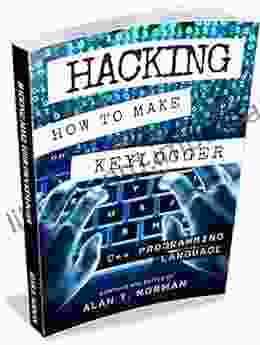Unveiling the Secrets of Keylogging: A Comprehensive Guide for Creating Your Own Keylogger

In the realm of cyber espionage and digital investigations, keyloggers play a pivotal role in capturing sensitive data and revealing hidden activities. With the advent of programming languages, individuals seeking to develop their own keyloggers now have a powerful tool at their disposal. This comprehensive guide will delve into the intricacies of keylogging, empowering you to create your own custom keylogger in a programming language of your choice.
Understanding Keylogging
A keylogger, as the name suggests, is a software program designed to record and log keystrokes entered on a computer or mobile device. This data can include passwords, credit card numbers, search queries, and any other information typed. Keyloggers can be installed remotely without the victim's knowledge, making them an effective tool for illicit activities such as identity theft, corporate espionage, and hacking.
4.1 out of 5
| Language | : | English |
| File size | : | 4286 KB |
| Text-to-Speech | : | Enabled |
| Screen Reader | : | Supported |
| Enhanced typesetting | : | Enabled |
| X-Ray | : | Enabled |
| Print length | : | 84 pages |
| Lending | : | Enabled |
Types of Keyloggers
Keyloggers come in various forms, each with its own unique capabilities and drawbacks. The three main types include:
- Hardware Keyloggers: These devices sit between the keyboard and computer, capturing every keystroke as it is pressed physically.
- Software Keyloggers: Installed as software on the target device, they operate invisibly in the background, recording keystrokes and other system information.
- Firmware Keyloggers: Embedded directly into the computer's or device's firmware, these keyloggers are extremely difficult to detect and remove.
Choosing a Programming Language
When it comes to developing your own keylogger, the choice of programming language depends on your experience and desired functionality. Some popular options include:
- Python: A versatile language with a vast library of tools for keylogging and other hacking tasks.
- C++: A powerful language that offers low-level access to system resources and can create highly efficient keyloggers.
- Java: A cross-platform language that allows for the development of keyloggers that can run on various operating systems.
- Assembly Language: A low-level language that provides precise control over the target computer's hardware, enabling the creation of sophisticated keyloggers.
Step-by-Step Keylogger Creation
The process of creating a keylogger involves several key steps:
- Establish a Mechanism for Keystroke Capture: This can involve using system calls or APIs in the chosen programming language to intercept keystrokes as they are pressed.
- Determine the Target Keystrokes: Specify the specific keys or combinations of keys that you want to log, such as passwords or sensitive information.
- Set Up a Logging Mechanism: Create a file or database to store the captured keystrokes for later retrieval.
- Conceal the Keylogger: Employ obfuscation techniques and stealthy methods to hide the keylogger from detection by antivirus software or system administrators.
- Implement Remote Access (Optional): For remote monitoring and data retrieval, consider integrating a remote access mechanism into your keylogger.
Ethical Considerations
While keyloggers can be a valuable tool in certain legitimate applications, it is crucial to use them responsibly and ethically. Installing a keylogger on a device without the owner's consent is illegal and can constitute a serious privacy violation. Always obtain proper authorization before deploying a keylogger, and ensure that its use is justified and in compliance with applicable laws.
With the knowledge gained from this comprehensive guide, you are now equipped to create your own custom keylogger in the programming language of your choice. Remember to exercise responsible and ethical practices when deploying keyloggers, and always prioritize the protection of privacy and data security.
4.1 out of 5
| Language | : | English |
| File size | : | 4286 KB |
| Text-to-Speech | : | Enabled |
| Screen Reader | : | Supported |
| Enhanced typesetting | : | Enabled |
| X-Ray | : | Enabled |
| Print length | : | 84 pages |
| Lending | : | Enabled |
Do you want to contribute by writing guest posts on this blog?
Please contact us and send us a resume of previous articles that you have written.
 Book
Book Novel
Novel Page
Page Chapter
Chapter Text
Text Story
Story Genre
Genre Reader
Reader Library
Library Paperback
Paperback E-book
E-book Magazine
Magazine Newspaper
Newspaper Paragraph
Paragraph Sentence
Sentence Bookmark
Bookmark Shelf
Shelf Glossary
Glossary Bibliography
Bibliography Foreword
Foreword Preface
Preface Synopsis
Synopsis Annotation
Annotation Footnote
Footnote Manuscript
Manuscript Scroll
Scroll Codex
Codex Tome
Tome Bestseller
Bestseller Classics
Classics Library card
Library card Narrative
Narrative Biography
Biography Autobiography
Autobiography Memoir
Memoir Reference
Reference Encyclopedia
Encyclopedia Henry Priest
Henry Priest Blue Bell
Blue Bell Alexander Dill
Alexander Dill Almedia Lee Exum
Almedia Lee Exum Alvin I Goldman
Alvin I Goldman Carl S Oplinger
Carl S Oplinger Lisa Turner
Lisa Turner Jill Milligan
Jill Milligan Allen M Schoen
Allen M Schoen Pavel Arazim
Pavel Arazim Alireza Bahadori
Alireza Bahadori George Makari
George Makari Albrecht Classen
Albrecht Classen Patricia Southern
Patricia Southern Gail Orum Alexander
Gail Orum Alexander John Mcdowell
John Mcdowell Alfredo Zotti
Alfredo Zotti Robert Bolton
Robert Bolton Eric Beuning
Eric Beuning Amanda Robins
Amanda Robins
Light bulbAdvertise smarter! Our strategic ad space ensures maximum exposure. Reserve your spot today!
 Dean CoxFollow ·14.9k
Dean CoxFollow ·14.9k Walt WhitmanFollow ·10.7k
Walt WhitmanFollow ·10.7k Ernesto SabatoFollow ·16k
Ernesto SabatoFollow ·16k Cody RussellFollow ·19.6k
Cody RussellFollow ·19.6k Cody BlairFollow ·12.2k
Cody BlairFollow ·12.2k Herb SimmonsFollow ·18.6k
Herb SimmonsFollow ·18.6k Ralph EllisonFollow ·11.4k
Ralph EllisonFollow ·11.4k Paul ReedFollow ·5.2k
Paul ReedFollow ·5.2k

 Ignacio Hayes
Ignacio HayesUnveiling the Secret Spitfires: Britain's Hidden Civilian...
: The Untold Story of Britain's...

 Scott Parker
Scott ParkerLiving With Schizophrenia: A Father and Son's Journey
Schizophrenia is a serious...

 Ted Simmons
Ted Simmons"From Sign Up to Pass Out": The Shocking and Immersive...
Step into the...

 John Keats
John KeatsThe Development of Biographies and Philosophical...
The Alluring...

 Dan Brown
Dan BrownCapture Your Dream Wedding with Digital Wedding...
Your wedding day is...
4.1 out of 5
| Language | : | English |
| File size | : | 4286 KB |
| Text-to-Speech | : | Enabled |
| Screen Reader | : | Supported |
| Enhanced typesetting | : | Enabled |
| X-Ray | : | Enabled |
| Print length | : | 84 pages |
| Lending | : | Enabled |














